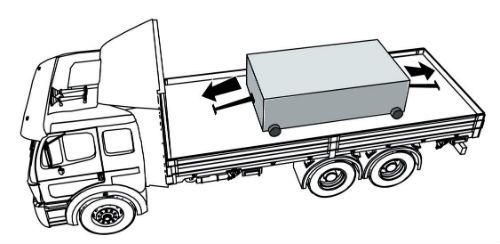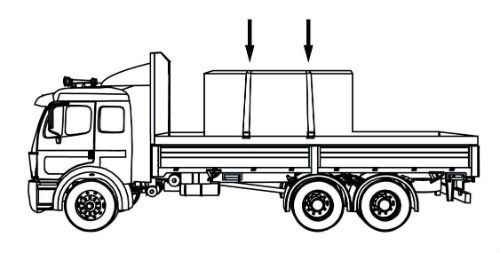CDL Practice Tests: Flatbed Cargo Securement
Choose A Section:
Go!The maximum distance from the rear allowed for attaching mechanisms used to secure roll-on/roll-off containers is:
- 2 feet
- It doesn't matter.
- 6 1/2 feet
- 3 feet

Attach mechanisms used to secure the rear end of a roll-on/roll-off or hook lift container no more than two meters (6.5 feet) from the rear of the container.
The term 'edge protector' refers to:
- A vertical barrier placed directly behind the cab of a tractor to protect the cab in the event cargo should shift forward.
- A rail along the side of a vehicle that protects the side of the vehicle from impacts.
- A device placed on the exposed edge of an article to distribute tiedown forces over a larger area of cargo than the tiedown itself, to protect the tie-down and/or cargo from damage, and to allow the tiedown to slide freely when being tensioned.
- A structure, device, or another substantial article placed against an article to prevent it from tipping that may also prevent it from shifting.
Edge protector:
A device placed on the exposed edge of an article to distribute tiedown forces over a larger area of cargo than the tiedown itself, to protect the tie-down and/or cargo from damage, and to allow the tiedown to slide freely when being tensioned.
Which of the following can be used as part of the cargo securement system?
- Vehicle structure.
- Securing devices.
- Blocking and bracing equipment.
- All of these are valid.
What is a securement system?

A securement system is a securement method that uses one or a combination of the following elements:
- Vehicle Structure.
- Securing Devices.
- Blocking and Bracing Equipment.
When securing concrete pipe loaded crosswise, arrange the top tier:
- Any of these are acceptable.
- As a partial tier in two groups.
- As a partial tier in one group.
- As a complete tier.
Requirements for arranging the top tier

Arrange the top tier as a complete tier, a partial tier in one group, or a partial tier in two groups.
When loading paper rolls with eyes horizontal, which of the following is not a requirement for stacking a second layer:
- Place second layer with eyes vertical.
- The bottom layer must extend all the way to the front.
- All the wells in the layer beneath must be filled
- It must be blocked against an eye-vertical blocking roll resting on the floor of the vehicle that is at least 1.5 times taller than the diameter of the roll being blocked.
Requirements for eyes crosswise: secure stacks of paper rolls from front-to-back movement
- Do not load paper rolls on a second layer unless the bottom layer extends to the front of the vehicle.
- Load paper rolls on higher layers only if all wells in the layer beneath are filled.
-
Secure the foremost roll in each upper layer (or any roll with an empty well in front of it) against forward movement:
- Either by placing it in a well formed by two rolls on the lower row whose diameter is equal to or greater than that of the roll on the upper row.
- Or by banding it to other rolls.
- Or by blocking it against an eye-vertical blocking roll resting on the floor of the vehicle that is at least 1.5 times taller than the diameter of the roll being blocked.
When securing paper rolls with eyes crosswise, which of the following can be used to prevent side-to-side shifting when there is more than 8 inches of space to the wall?
- Any of these methods are acceptable.
- Tiedowns.
- Void fillers.
- Friction mats.
Requirements for eyes crosswise: prevent rolls from shifting toward either wall
If there is more than a total of 203 mm (8 in) of space between the ends of a paper roll and other rolls or the walls of the vehicle, use one of these methods:
- Void fillers (such as honeycomb)
- Blocking
- Bracing
- Friction mats
- Tiedowns
Define 'bolster':
- A crosswise load bearing structural component, particularly a part of a log bunk.
- An inflatable bag intended to fill otherwise empty space between articles of cargo, or between articles of cargo and the wall of the vehicle.
- A structure, device, or another substantial article placed against or around an article to prevent horizontal movement of the article.
- A vertical barrier across the front of the deck of a vehicle to prevent forward movement of cargo.
Bolster:
A crosswise load bearing structural component, particularly a part of a log bunk.
As part of their pre-trip cargo securement inspection, drivers should:
- Inform carrier of any inadequate packaging.
- All of these apply.
- Make sure cargo is properly secured.
- Check for anything that will obscure their vision.
Driver inspection checklist:
Pre-Trip
- Make sure that cargo is properly distributed and adequately secured (in other words, according to the Standard).
- Make sure that all securement equipment and vehicle structures are in good working order and used consistent with their capability.
- Stow vehicle equipment.
- Make sure that nothing obscures front and side views or interferes with the ability to drive the vehicle or respond in an emergency.
-
Inform carrier if packaging is not adequate. For example:
- Banding is loose or not symmetrical on package.
- Banding attachment device(s) are inefficient.
- Wrapping is broken or ineffective.
- Pallets are broken.
A tiedown is defined as:
- A combination of securing devices which form an assembly that attaches cargo to, or restrains cargo on, a vehicle or trailer, and is attached to anchor point(s).
- A strip of material that may be used to unitize articles and is tensioned and clamped or crimped back upon itself. (same as "Strapping")
- A rail along the side of a vehicle that protects the side of the vehicle from impacts.
- A structure, device, or another substantial article placed against or around an article to prevent horizontal movement of the article.
Tiedown:
A combination of securing devices which form an assembly that attaches cargo to, or restrains cargo on, a vehicle or trailer, and is attached to anchor point(s).
What is the minimum WLL of each tiedown used to secure crushed or flattened vehicles?
- 10,000 lbs
- It depends on the vehicle
- 5,000 lbs
- 2,268 lbs
Option 2:
Has containment walls on three sides that:
- Extend to the full height of the load
- Block against cargo movement in the forward, rearward, and one sideways direction.
Secures each stack of vehicles with a minimum of two tiedowns, each having a minimum WLL of 2,268 kg (5,000 lb.).
Option 3:
Has containment walls on two sides that:
- Extend to the full height of the load.
- Block against cargo movement in the forward and rearward.
Secures each stack of vehicles with a minimum of three tiedowns, each having a minimum WLL of 2,268 kg (5,000 lb.).
Option 4:
Has a minimum of four tiedowns per vehicle stack with each tiedown having a minimum WLL of 2,268 kg (5,000 lb.).
About The Flatbed Cargo Securement CDL Manual
Studying the flatbed cargo securement CDL manual is not a requirement for getting your CDL permit or license. It is required knowledge for flatbed drivers.
Some questions you should be able to answer for flatbed cargo securement:
- What is the minimum Working Load Limit of a tiedown used to secure logs?
- What is the minimum weight of a shipment of paper rolls that would require specific securement requirements?
- When securing concrete pipe over 45 inches loaded crosswise, which direction must the tiedowns on the front half of the load run?
- What is a cab shield?
- When securing concrete pipe over 45 inches loaded crosswise, which direction must the tiedowns on the rear half of the load run?
- What is a dunnage bag?
- Who is responsible for inspecting securing devices and cargo within the first 50 miles?
- How many tiedowns are required on a stack of shortwood loaded crosswise?
- What is the minimum working load limit of each tiedown used to secure crushed or flattened vehicles?
- Define 'bolster'
- What is a hook-lift container?
- When a tiedown is attached directly to the cargo, what is the ideal angle where it attached to the vehicle?
What is a securing device?
Any device specifically manufactured to attach or secure cargo to a vehicle or trailer:
- Synthetic Webbing
- Chain
- Wire rope
- Manila rope
- Synthetic rope
- Steel strapping
- Clamps and latches
- Blocking
- Front-end structure
- Grab hooks
- Binders
- Shackles
- Winches
- Stake pockets
- D-rings
- Webbing ratchet
- Bracing
- Friction mat
What is a tiedown?
A combination of securing devices that forms an assembly that:
- Attaches cargo to, or restrains cargo on a vehicle.
- Is attached to anchor point(s).

Some tiedowns are attached to the cargo and provide direct resistance to restrain the cargo from movement.

Some tie-downs pass over or through the cargo. They create a downward force that increases the effect of friction between the cargo and the deck. This friction restrains the cargo.
 Related Cargo Securement Terms That Every Driver Should Know:
Related Cargo Securement Terms That Every Driver Should Know:
-
Tiedown:
A combination of securing devices which form an assembly that attaches cargo to, or restrains cargo on, a vehicle or trailer, and is attached to anchor point(s).
-
Contained:
Cargo is contained if it fills a sided vehicle, and every article is in contact with or sufficiently close to a wall or other articles so that it cannot shift or tip if those other articles are also unable to shift or tip.
-
Blocking:
A structure, device, or another substantial article placed against or around an article to prevent horizontal movement of the article.
How should tiedowns be attached?
Tiedowns can be used in two ways:
-
Attached to the cargo:
- Tiedowns attached to the vehicle and attached to the cargo.
- Tiedowns attached to the vehicle, pass through or aroundan article of cargo, and then are attached to the vehicle again.
-
Pass over the cargo:
- Tiedowns attached to the vehicle, passed over the cargo, and then attached to the vehicle again.
Tiedown placement:

Place the tiedown as close as possible to the spacer.
Position the tiedowns as symetrically as possible over the length of the article.

Position the tiedowns to preserve the integrity of the article.







 TT On Facebook
TT On Facebook